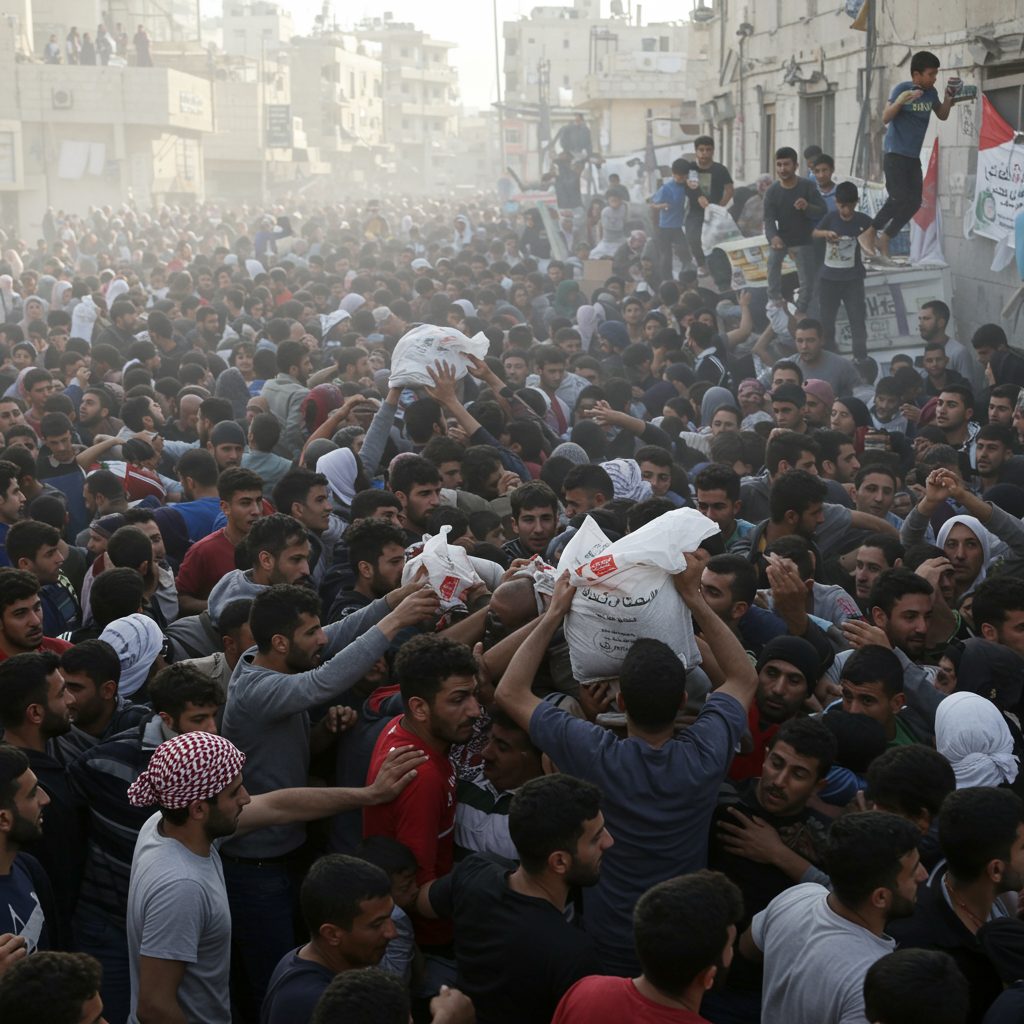Gaza’s humanitarian crisis has intensified, with reports of extreme chaos and desperation at food distribution points. Leaked videos and firsthand accounts reveal a brutal scramble for survival, where thousands vie for meager supplies. These scenes underscore a deepening catastrophe, highlighting the immense challenges in delivering vital aid amidst a complex and volatile conflict zone. The situation is a stark reminder of the urgent need for effective, impartial humanitarian efforts to reach a population teetering on the brink of famine.
The Dire Reality: Chaos at Gaza’s Aid Hubs
The grim spectacle of people running, then surging, for food supplies has become a recurring nightmare across Gaza. Eyewitness testimonies and satellite imagery paint a devastating picture of distribution centers overwhelmed by sheer desperation. Young people often arrive before dawn, holding empty sacks, only to be told that critical items like sugar or flour are unavailable. The overwhelming demand frequently devolves into disarray, challenging even the most organized aid efforts.
Eyewitness Accounts of Desperation
Reports from newly opened US-backed food aid distribution centers near Rafah and in central Gaza depict a harrowing struggle. Thousands of Palestinians, many walking for miles, have overrun facilities in desperate attempts to secure food. Eyewitnesses describe chaotic scenes where crowds surge into barbed-wire areas containing food pallets. Armed contractors, initially overseeing distribution, sometimes retreat as the situation spirals into a free-for-all.
One man on crutches recounted walking for hours only to leave empty-handed, lamenting the lack of food for his children. Others described seeing “gangs” carry off large quantities of aid, leaving little for vulnerable families. The desperation is so profound that some resorted to tearing down fences. Staff, overwhelmed, have reportedly fired sound grenades. As people flee in panic, gunshots have been reported, resulting in shrapnel injuries. Women, like Aisha Na’na, returned with only sticks for firewood, unable to secure food for their children.
The Role of the Gaza Humanitarian Foundation (GHF)
Many of these new distribution points are operated by the Gaza Humanitarian Foundation (GHF). This organization, which is backed by the U.S. and Israel, aims to feed approximately half of Gaza’s population. GHF has initiated operations at multiple sites, including two near Rafah and one in central Gaza. Their stated goal is to distribute tens of thousands of food boxes, each designed to provide meals for several days.
However, the GHF’s operations have been plagued by controversy and criticism. Despite claims of orderly distribution and denials of casualties at their sites, medical reports tell a different story. Hospitals have reported treating numerous patients with gunshot wounds sustained at or near these distribution centers. One 17-year-old girl and a man in his 20s were treated for chest and stomach wounds after seeking aid. The GHF has, on occasion, admitted that their American security subcontractors temporarily “fell back” due to immense demand. The CEO of GHF even resigned, citing frustrations over Israeli restrictions and concerns about the mission’s impartiality.
Competing Narratives: Who is to Blame for Aid Shortfalls?
The humanitarian crisis in Gaza is compounded by a bitter blame game between involved parties. Each side presents a different narrative regarding the obstacles to effective aid delivery. This disagreement further complicates efforts to provide much-needed relief to the starving population. Understanding these contrasting viewpoints is crucial to grasp the full complexity of the situation.
Israeli Perspective and Accusations
The Israeli military has acknowledged facilitating the entry of hundreds of truckloads of supplies into Gaza. The Coordinator of Government Activities in the Territories (COGAT) has accused the United Nations of failing to collect and distribute aid effectively. Israeli officials claim that over 400 truckloads of humanitarian aid have awaited collection on the Israeli side of the Gaza border. They also frequently blame Hamas for the crisis, alleging aid theft and diversion. The military states its commitment to ensuring aid reaches civilians while preventing it from falling into Hamas’s hands. Warning shots have been confirmed to control crowds, though the IDF denies causing fatalities in these instances, stating they target “suspects” posing threats.
UN and Aid Agencies’ Stance
In stark contrast, the UN and other major humanitarian organizations have largely refused to participate in the GHF mechanism. They argue that this system violates fundamental humanitarian principles of independence, neutrality, and impartiality. UN officials highlight significant “obstacles” to aid delivery within Gaza, including rubble-choked roads, ongoing airstrikes, and stringent Israeli military restrictions. They deny that widespread aid diversion by Hamas occurs, asserting that the primary issues stem from access limitations imposed by Israeli authorities. UN agencies also point out that Israeli authorities have, at times, not granted permission for their trucks to access border points to retrieve incoming supplies for distribution.
Underlying Causes of Gaza’s Hunger Crisis
The current aid chaos is merely a symptom of a much deeper, pervasive hunger crisis in Gaza. The population of 2.3 million Palestinians faces an extreme scarcity of food, a situation that has escalated dramatically over recent months. This severe deprivation is driven by a combination of blockades and the destruction of local infrastructure, creating an environment ripe for catastrophic famine.
The Escalating Famine Risk
Since a near-complete blockade was imposed earlier in the conflict, virtually all of Gaza’s 2.3 million residents are at a critical risk of famine. The partial lifting of the blockade has done little to alleviate the immense suffering. Prices for essential goods have skyrocketed, with a kilogram of sugar costing up to 60 times its pre-war price. A 25kg bag of flour, a staple, can now fetch as much as $500. Fuel, fresh vegetables, and meat have become largely unobtainable for the vast majority of the population. This severe deprivation has pushed the entire population to the brink of starvation.
Obstacles to Effective Aid Delivery
Even when humanitarian aid manages to enter Gaza, its distribution faces immense logistical and security hurdles. Roads are often impassable due to rubble and debris from bombardments. Israeli military restrictions on movement and ongoing airstrikes create a perilous environment for aid workers. There are also growing instances of anarchy, with desperate civilians and even criminal gangs intercepting aid trucks. Aid workers describe a “lethal chaos” where aid, if it reaches northern entry points, is often stopped and offloaded before reaching its intended destinations. Despite dispatching thousands of tonnes of food, agencies report this is a “tiny fraction” of what is truly needed.
Geopolitical Ramifications and Humanitarian Principles
The complexities surrounding aid distribution in Gaza extend beyond logistics, touching upon deeply contentious geopolitical issues and fundamental humanitarian principles. The methods employed for aid delivery raise serious concerns about data privacy and the broader implications for the civilian population’s future. These factors further fuel the distrust and challenges faced by international aid organizations.
Concerns Over Biometric Data and Control
A highly contentious aspect of the GHF’s operation is the reported requirement for mandatory biometric screenings, including facial recognition technology, for anyone seeking food. This mandate has sparked fears among Palestinians that their sensitive biometric data could fall into Israeli hands. This concern is a significant reason why the United Nations and other international aid groups have boycotted the GHF. They accuse the GHF of undermining the fundamental humanitarian principles of independence, neutrality, and impartiality by integrating such technologies and operating under what is perceived as Israeli oversight. Hamas has also warned Palestinians to avoid GHF sites, alleging they are part of an Israeli plot to coerce civilians into specific neighborhoods and facilitate military operations.
The Wider Conflict’s Shadow
The chaotic scenes at aid hubs are inextricably linked to the broader conflict. The war, initiated by Hamas’s October 7, 2023, attack, has resulted in a devastating death toll in Gaza, with the health ministry reporting over 55,600 casualties, predominantly civilians. This ongoing violence and the desperate conditions are leading to immense human suffering and displacement. The international community largely considers new Israeli settlements in the occupied West Bank, announced concurrently with the aid crisis, as illegal and a significant impediment to peace. The intertwining of military operations, humanitarian crisis, and political maneuvering creates an incredibly challenging environment for any meaningful resolution to the suffering.
Frequently Asked Questions
What is the Gaza Humanitarian Foundation (GHF) and why is it controversial?
The Gaza Humanitarian Foundation (GHF) is a U.S.- and Israeli-backed private organization established to distribute food aid in Gaza. It became controversial due to its operational model, which reportedly includes mandatory biometric screenings like facial recognition technology for aid recipients. This, coupled with Israeli military oversight, led to accusations from the UN and other aid groups that GHF compromises humanitarian principles of neutrality and independence. Critics also cite reports of chaos and casualties at GHF sites, despite the organization’s denials.
Where are the primary challenges in delivering aid within Gaza?
Delivering aid within Gaza faces multiple severe challenges. Roads are often impassable due to extensive damage from bombardments. Israeli military restrictions significantly impede the movement of aid trucks, and ongoing airstrikes create dangerous conditions for humanitarian operations. Furthermore, growing desperation and lawlessness have led to instances of civilians and criminal gangs intercepting aid convoys before they reach distribution points, further exacerbating the dire supply situation.
What are the reported dangers for civilians attempting to access aid in Gaza?
Civilians attempting to access food aid in Gaza face significant dangers. Eyewitness accounts and medical reports indicate that Israeli forces have fired warning shots or projectiles to control crowds at distribution centers, resulting in numerous injuries and some reported deaths. The sheer volume of desperate people often leads to dangerous stampedes and chaotic surges. Additionally, there are reports of theft and violence among civilians competing for scarce resources, making the process of obtaining aid a perilous endeavor.
Conclusion
The scenes unfolding at Gaza’s food distribution hubs are a stark and heartbreaking illustration of an escalating humanitarian catastrophe. What should be an organized, dignified process of aid delivery has devolved into a desperate struggle for survival, marked by chaos, violence, and profound human suffering. The deep chasm between the narratives of aid organizations, the Israeli military, and local authorities underscores the immense complexity of this crisis. Genuine, impartial humanitarian action, unhindered by political agendas or military operations, remains the only path forward to alleviate the suffering of Gaza’s population. Without a concerted, collaborative effort focusing solely on human dignity, the “desperate food struggle” will only continue to intensify, pushing more lives to the brink.




